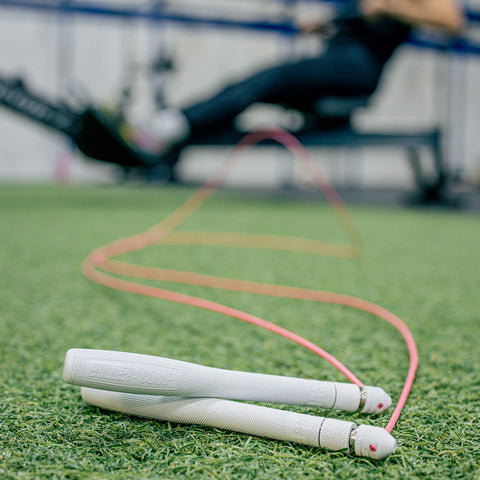How Jump Rope Compares to Other Cardio Exercise
Nov 22, 2023Matt Hopkins

Jumping rope is a top-notch workout for many reasons: it’s easy for beginners to enter, takes up very little space, and is cost-effective. It’s also a killer calorie-blaster: jumping rope can burn up to 15 - 20 calories per minute. One fifteen-minute session clocks in at about 250 - 300 calories.
Jumping rope makes you breathe hard and gets your heart pumping. In fact, it’s such an effective cardiovascular exercise that the American Heart Association created an entire event around it: Jump Rope for the Heart!
That’s tough to beat. So, how does jumping rope compare with other forms of cardio? Read on to find out.
Try our Jump Rope Calorie Calculator
Cardiovascular exercise, or cardio, is defined as any physical activity that uses “aerobic metabolism.” Aerobic metabolism is a chemical process during which your body derives energy from the combustion of fats, carbohydrates, and amino acids in oxygen.

When you’re using your large muscle groups during a cardiovascular workout, you’ll find yourself breathing hard. Your body is in the process of taking in more oxygen to fuel your high-energy activity. Your heart is pounding to pump more oxygenated blood through your body. By practicing cardio often, the efficiency of the heart is increased.
Regular cardio exercise provides a slew of benefits: better sleep, weight loss, increased metabolic rate, improved mental health, and of course, heart health. Try to get at least 150 minutes of cardio per week to decrease the risk of heart disease and inflammation.

Running and jump roping are frequently compared because of their similar benefits. Both jump roping and jogging are excellent cardiovascular workouts. And, they’re both accessible, cheap activities to practice. These two exercises also work many of the same large muscles in your arms, legs, and hips.
Depending on your weight, half an hour of running burns around 300 - 500 calories. The same amount of time jumping rope burns about 500 - 600 calories. According to this study, just ten minutes of jumping rope per day will improve cardiovascular health as much as thirty minutes of jogging per day.
While running is beneficial, it’s also tough on your body. Running is defined as a high-impact sport. Because you are repeatedly pounding the ground with force, the exercise causes a greater impact on joints and feet. Many runners suffer from injuries – up to 50% of regular runners get hurt every year. In contrast, jumping rope is considered a low-impact sport, as long as you know how to jump properly. In fact, the repeated low-level impact of jumping increases bone density. We recommend a jump rope mat to reduce the impact on your joints further.
Check out this article for more detail on running versus cardio.
Verdict: Jump roping is easier on your body and burns more calories than running.

How does jump rope compare to HIIT workouts? Jump rope can be a HIIT workout. HIIT (High-Intensity Interval Training) is based on a particular workout structure that consists of bursts of intense physical movement for a short period of time followed by a low-intensity rest period. Like standard jump roping, one of the best parts about HIIT workouts is how quickly you can get them done. One session can last just 10 - 30 minutes. And, the calories keep burning after you’ve finished.
There are plenty of jump-rope-specific HIIT workouts to follow, or you can create your own. You’ll find one in this article, for starters.
Verdict: You don’t have to choose between HIIT workouts and jump roping because you can apply HIIT principles to your jump rope routine.
Swimming and jumping rope are great workouts that’ll keep you in tip-top shape. While it may look like you’re using more of your body during butterfly or freestyle swimming, jumping rope actually engages more muscles. In terms of cost, pool membership and ownership are considerably more expensive than owning a jump rope.
A half an hour of swimming should expend about 250 calories while jumping rope will land you at 500 - 600 calories.
Even though jumping rope is a low-impact sport, swimming has almost zero impact. You’re practically weightless in a pool, so those suffering from chronic pain or injuries may be better suited for an aquatic workout.
Verdict: Swimming is easier on your joints than jumping rope, but jumping rope remains a low-impact sport that’ll burn more calories.
Boxers love jumping rope: it helps them practice concentrated bursts of energy, mimics the transfer of weight from foot to foot, and it increases mobility in the shoulder's glenohumeral joint – a necessity for the perfect punch. However, a boxing gym membership is costlier than purchasing a jump rope.
Using a punching bag for half an hour will burn about 300 - 400 calories. It’s a fantastic burner, but still brings in less than jump rope’s 500 - 600 calories.
Boxing is often a two-person sport and a dangerous one at that. Boxers face injuries like facial lacerations, broken hands and fingers, and concussions. Jumping rope proves to be a lower-risk activity, even if you’re doing double dutch.
Verdict: Boxing is dangerous and doesn’t burn as many calories as jump roping. However, these two sports influence each other positively.
While biking strengthens your glutes, legs, and hips, the upper body is missing out on the action. Jumping rope activates your entire upper and lower body, from arms to core to legs. If you’re bike riding in a hilly area, the resistance of the incline will cause your muscles to grow. As you push to climb your leg muscles go through a process called hypertrophy in which muscle fibers tear apart and repair themselves to become stronger.
Biking for half an hour will burn about 200 - 350 calories depending on your height and weight. Jumping rope remains superior to this exercise by claiming 500 - 600 calories in half an hour.
Jumping rope to work won’t exactly make your commute any faster. Biking is a good way to combine mobility and exercise. And, you’ll get to absorb some lovely scenery. The downside: bikes, gear, and maintenance can become costly quickly.
Verdict: Biking is a great way to combine transportation and exercise, but jumping rope still has biking beat in the calorie-burning department.
Absolutely! Jumping rope is a highly effective cardio exercise, burning up to 500-600 calories per half-hour session. Jumping rope is also gentler on the joints than exercises like running and remains a low-impact, cost-effective, and efficient choice for an all-encompassing cardio routine.
You can expect to burn approximately 140-190 calories for every 1000 skips if you jump rope at a moderate pace. However, this will vary based on factors such as age, body mass, and exercise intensity.
Explore More:
What Happens If You Jump Rope Every Day?
How Jumping Rope Impacts Your Aerobic and Anaerobic Systems, Based on Research
Weight Lifting or Cardio When You're Over 35?
What Type of Jump Rope Burns the Most Calories?
About the AuthorMatt Hopkins is a former competitive speed jumper and jump rope coach. Matt has won numerous national championships in speed jumping, and his athletes have won several national speed and freestyle titles and have broken world and national speed records. He also taught middle and elementary school PE in Leavenworth WA for 23 years. |
We're all about equipping and encouraging people to take on big challenges, because we know the process of doing hard things helps us grow in character and capacity.
Frequently bought together
You may also like
3 Comments
Runner here who jumps rope on rest days, running and jump roping are two different animals, but indeed jumping rope is an excellent cardio workout!
Hi Nanda, I would recommend our Facebook community with more than 1000 jumpers sharing tricks, skills and ideas. https://www.facebook.com/groups/1286318605312629/
Also, our jump rope app just launched and has a community section where people will be sharing knowledge. You can download for iphone or Android https://elitejumps.co/pages/jump-rope-app
This is a great article for jump ropes fans like me…. Can you please suggest any online forums for knowledge share? Tks.